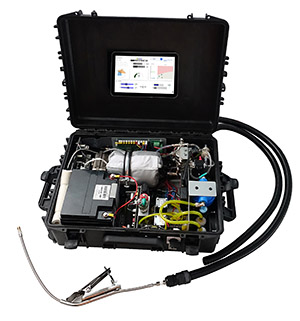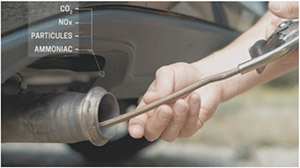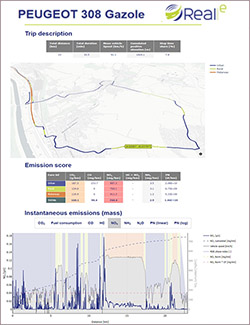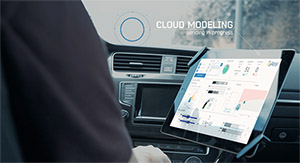According to the WHO, 7 million premature deaths worldwide each year are linked to poor air quality, a problem to which road transport makes a significant contribution. Thanks to regulatory and technological developments, as well as the renewal of the vehicle fleet, emissions from this sector have certainly been falling in recent years. However, it remains a major contributor to the deterioration of air quality, with, for example, 49% of NOx emissions in France in 2020 (half of which from private vehicles) and 13% of PM2.5 emissions1 (1/3 of which from private vehicles).
An assessment of the implemented remediation solutions (vehicle technologies, infrastructures, uses) must be based on a precise, exhaustive and reliable diagnosis of both the sources (raw gases at emission points) and the resulting air quality (diluted gases and generation of secondary pollutants). In addition, air quality can be greatly affected by local conditions (confinement, meteorology, etc.), and vehicle emission levels are highly sensitive to their actual usage conditions. As such, it is crucial to equip ourselves with the tools needed to assess the latter and their impact on pollutant emissions.
In this context, the approach proposed by IFPEN to relate vehicle emissions to actual driving conditions couples:
- on-road measurement;
- vehicle-scale modelling;
- large-scale collection of usage data.
For any geographical area of interest (urban centre, residential, close to traffic, etc.), this approach makes it possible to quantify the variability of emissions in real use as a function of the vehicle fleet and driving behaviour, in order to envisage appropriate remediation solutions.
Design of measurement system
Research work has focused on ultraviolet spectroscopy, culminating in the ELEMENTS multi-gas analysis system [1,2], which measures nitrogen oxides (NOx) among other things, and current developments are exploring its use as a tool for quantifying fine particles.
The development of the chemometric algorithm required the set-up of a digital testing platform in order to simplify the calibration phase.
The developed tool makes it possible to create composite spectra combining information from the literature (reference spectra) and the noise and defects of the actual optical system (light source, spectroscope, optical path). This has served to broaden the range of measurable compounds: combustion indicators O2, H2O)2 and certain industrial pollutants (H2S, Cl2, Benzene, Toluene), in addition to the panel of gases already characterized (NO, NO2, NH3, SO2).
Thesis work [3] has also validated the feasibility of exploiting the scattering properties of combustion particles in ultraviolet as a function of their physical and chemical properties.
Roll-out of field measurements
To measure emissions at the heart of road traffic, the ELEMENTS analyser has been integrated into the "RealE" on-board measurement system (see figure 1) [2, 4].
This tool has been used to assess the environmental performance of passenger cars as part of a study for the public authorities. It has made it possible to provide objective data on actual emissions from vehicles meeting the latest emission standards (Euro 6), while also focusing on certain compounds not yet regulated (Euro 7) [5].
The RealE analyser is also at the heart of several studies:
- for Ademe (French Environment and Energy Management Agency), with the aim of assessing the potential of on-board measurement for increased monitoring of vehicle fleet performance [6];
- as part of the European LENS project, dedicated to assessing and reducing emissions from 2-wheelers [7].
 |
 |
|
|
Figure 1: Illustrations of the RealE on-board analysis system
|
 |
|
These studies under real-life conditions were preceded by extensive laboratory campaigns, for example as part of the RHAPSODIE 1 and 2 studies3, which made it possible to draft a comprehensive overview of vehicle emissions, both regulated and unregulated, gaseous and particulate4, while also determining the impact of biofuels introduced at different rates [8].
Extension to vehicle fleets and territories
Working in close synergy with IFPEN's "Digital Science and Technology" division, the "Mobility and Systems" division is carrying out research to model road transport emissions under a variety of real-life conditions, and to derive simulations not just for a given vehicle, but on the scale of the vehicle fleet, across a territory encompassing a multitude of engine technologies and usage cases.
This approach has notably been deployed to assess the relevance of various levels of electrification for the decarbonization of passenger cars [9, 10].
Development of remediation solutions
To limit pollutants at the source, work is being carried out with IFPEN's "Catalysis, Biocatalysis and Separation" division, to find innovative treatment solutions. For example, high-capacity NOx adsorbents based on zeolites have been developed [11].
Compared with the state of the art, the developed zeolites can also be used in selective ammonia reduction (NH3-SCR), thereby resulting in a gain in terms of reaction initiation temperature and hydrothermal stability of the catalyst [12].
1- Particles with diameter ≤ 2.5 µm.
2- Measured in combustion products in order to monitor mixture richness, and also to switch from dry to wet measurement.
3- Conducted in connection with the ADEME CORTEA calls for projects (Knowledge and reduction of air pollutant emissions).
4- 150 compounds studied, as well as particle number measurement.
Bibliographic references
-
Method and system for optically measuring the concentration of gaseous species of exhaust gases (Procédé et système de mesure optique de la concentration d'espèces gazeuses de gaz d'échappement)
>> Patent WO2019020326
-
Schiffmann, P., Kermani, J., Dégeilh, P., Frobert, A., Agouzoul,Y., Robust and Affordable IoT Solution for In-service Conformity Testing, SAE Technical Paper 2020-01-2187, 2020.
>> https://doi.org/10.4271/2020-01-2187
-
Mouad DAOUDI, Development of optical and chemical diagnostics to characterize and control particulate and gaseous emissions from combustion systems (Développement de diagnostics optiques et chimiques pour caractériser et contrôler les émissions particulaires et gazeuses des systèmes de combustion), defended on 07/12/2022.
>> https://www.theses.fr/2022ULILR062
-
Schiffmann P., Frobert A. and Agouzoul Y., REAL-e a compact measurement system for regulated and unregulated emissions, SIA Congress, 2020
-
Philippe Dégeilh, Joseph Kermani, Jules Sery, Pierre Michel. Study of Euro 6d-TEMP emissions - IFPEN for DGEC: Summary report. [Research Report] Ministère de l'Ecologie. 2020. ⟨hal-03632915⟩
>> https://hal-lara.archives-ouvertes.fr/hal-03632915/
-
SESAME project
>> https://librairie.ademe.fr/air-et-bruit/5736-projet-sesame.html
-
LENS project
>> https://www.lens-horizoneurope.eu/
-
RHAPSODIE 2 project
>> https://librairie.ademe.fr/air-et-bruit/6032-projet-rhapsodie-2.html
-
Roland Dauphin, Vivien Prevost, Philippe Dégeilh, Joris Melgar, Corrado Fittavolini, Alastair Smith, Cyrille Callu, Sofia Chrysafi, Renate Uitz-Choi, Kenneth Kar, Evaluation of plug-in hybrid vehicles in real-world conditions by simulation, Transportation Research Part D: Transport and Environment, Volume 119, 2023, 103721, ISSN 1361-9209
>> https://doi.org/10.1016/j.trd.2023.103721
-
Concawe – Welcome to the cars CO2 comparator!
>> https://www.carsco2comparator.eu
-
Synthesis of a palladium-containing AFX zeolite catalyst for NOx adsorption
>> Patent WO2022243164
Synthesis of a palladium-containing AFX-BEA zeolite composite catalyst for NOx adsorption
>> Patent WO2022243165
-
Rapid synthesis of a catalyst comprising an AFX structural-type zeolite and at least one transition metal for the selective reduction of NOx
>> Patent WO2020212354
Scientific contact: philippe.degeilh@ifpen.fr






